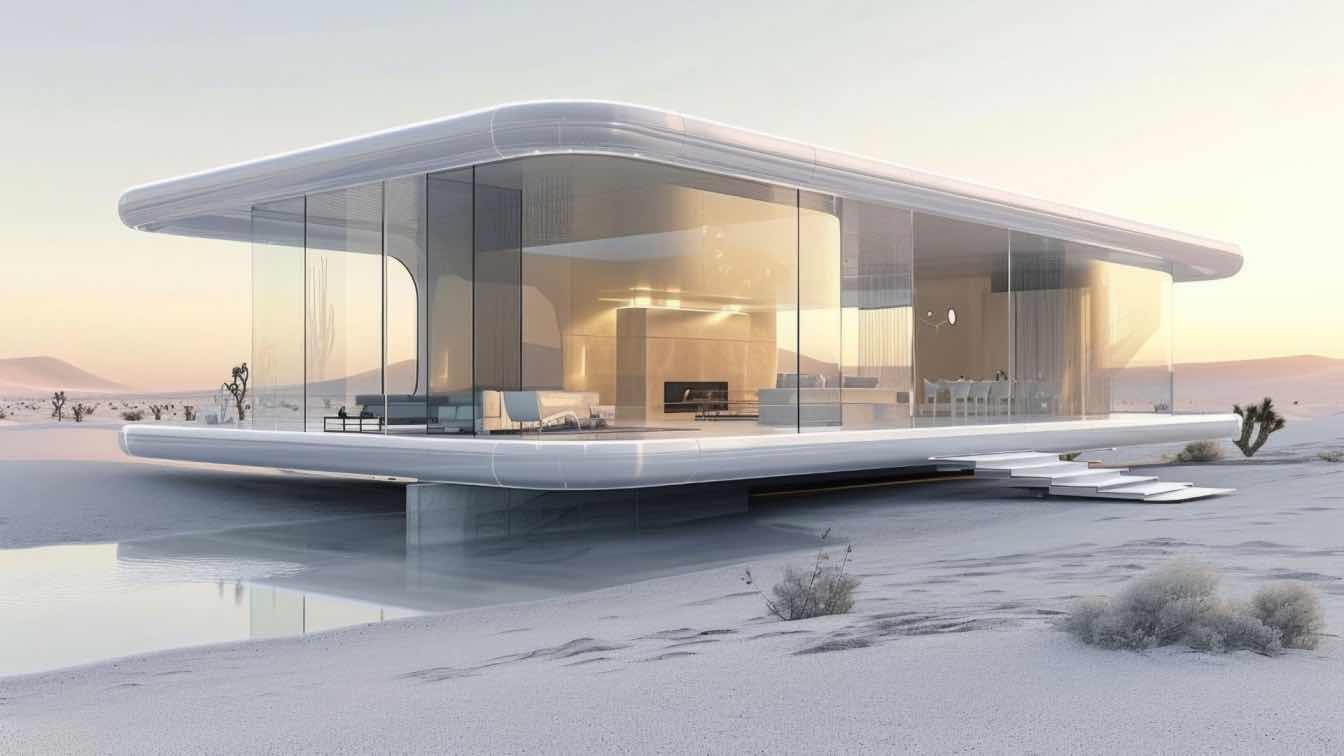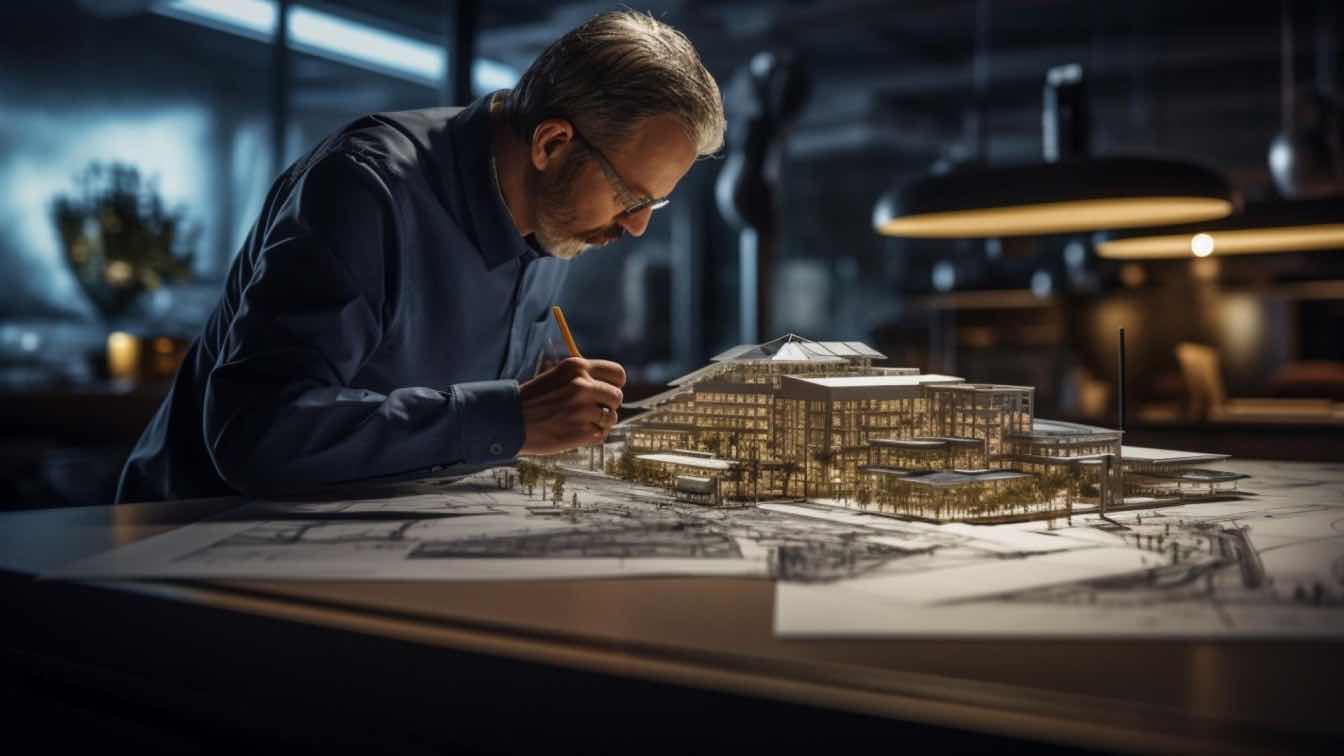The architectural world is undergoing a technological shift, with AI revolutionizing visualization through predictive and generative algorithms. Expert findings from All About AI reveal that 77% of companies are already leveraging AI or actively exploring its potential, with the market projected to grow from $20.9 billion to $148.4 billion by 2029.
From concept to execution, AI enhances creativity and efficiency, replacing traditional methods like manual sketches with dynamic, machine-learning-powered representations. This technological advancement is streamlining workflows and pushing the boundaries of design possibilities.
Architectural visualization now offers advanced tools to predict, generate, and refine designs. These tools not only enhance outcomes but also help stakeholders better understand spatial characteristics, materials, and lighting before construction begins.
The Role of Predictive Algorithms in Architecture
Predictive algorithms use data to anticipate outcomes. This enables architects to make informed decisions about materials and environmental impacts. Projects like the Czech Promotion Offices in Prague show how predictive algorithms aid in making efficient design choices.
These algorithms help foresee how a building interacts with its surroundings. For example, they determine how sunlight will filter into a room throughout the day.
They also predict how wind affects structural integrity. This ability to forecast environmental factors enables efficient and sustainable design choices.

Predictive AI tools are indispensable in urban planning. Architects must understand how structures will fit into neighborhoods.
By analyzing historical data and traffic patterns, AI helps predict the implications of new developments. This allows for better design consideration, minimizing negative impacts on surrounding areas.
This enhances aesthetic outcomes and supports sustainable development.
Moreover, predictive algorithms aid architects during initial design phases. They estimate construction costs, labor, and timelines based on similar past projects.
This accuracy helps keep projects within budget. It also helps communicate realistic timelines to clients, minimizing surprises.
Generative Design: Letting AI Take the Creative Lead
Generative design is an exciting application of AI in architectural visualization. It uses algorithms to explore a multitude of design options rapidly.
Architects set parameters like space requirements and structural constraints. AI then generates a range of possibilities that meet these criteria.
This automation doesn’t replace the creative vision of architects. Rather, it enhances it.
AI generates numerous options, allowing architects to focus on refining and humanizing the design. Generative design approaches, like those used in the Zhuzhang Showroom Office in Shenzhen, demonstrate the potential for dynamic and functional spaces.
Some choices might be unconventional. This ability to push beyond the obvious leads to more innovative, functional structures.
Generative design is valuable in early project phases. During brainstorming, generative algorithms offer different conceptual solutions.
This empowers architects with a broader vision of what’s possible. AI saves time in generating concepts and pushes creative boundaries.
It suggests layouts and forms that might not have been considered otherwise.
Streamlining the Visualization Process
Traditionally, architectural visualization was labor-intensive. AI is streamlining the creation of 3D models, renderings, and animations.
| Traditional Visualization | AI-Enhanced Visualization |
| Manual drawings and static graphics | Automated 3D models and renderings |
| Labor-intensive and time-consuming | Faster and real-time adjustments |
| Limited creative exploration | Generative design options |
AI-based software generates photorealistic visualizations faster. It adjusts models in real-time as design changes are made. This responsiveness is beneficial for client presentations. It allows for immediate feedback and iteration.
Deep learning algorithms create realistic textures, lighting effects, and finishes. These are challenging aspects of visualization that AI handles effectively.

Instead of spending hours rendering each element, AI produces high-quality visuals. These visuals accurately represent the final product.
This improves efficiency and enhances visual quality. It makes it easier for clients to understand and get excited about the design.
AI also impacts virtual reality (VR) and augmented reality (AR). AI-enhanced VR and AR allow clients to experience a space in an immersive way.
Clients can walk through rooms and interact with environments before construction starts. This immersive technology helps clients make better-informed decisions.
Enhancing Collaboration and Customization
AI facilitates better collaboration among stakeholders. Predictive and generative AI tools allow real-time visualization of changes.
This includes everyone from engineers to interior designers. Collaboration becomes smoother and more efficient.
It reduces back-and-forth, ensuring everyone is on the same page. AI also allows for greater customization in design.
Generative algorithms can tailor designs to specific client needs and preferences. For example, AI can analyze a client's activities and generate a layout that maximizes comfort.
This level of customization was previously possible only through lengthy discussions. AI makes it more accessible and precise.
The Future of AI in Architectural Visualization
AI’s impact on architectural visualization is still in its early stages. The potential for future growth is immense.
As machine learning evolves, AI's ability to handle complex tasks will improve. It will generate even more lifelike visualizations.
Architects are exploring AI-driven design that evolves over time. Buildings could adapt to environmental changes or new user needs.
Another development is integrating AI with smart city technologies. Future tools could connect architectural visualization with real-time urban data.
Designs could respond dynamically to changing conditions like population growth or energy consumption. This would lead to adaptable, resilient urban landscapes.
These landscapes would be better equipped to meet 21st-century challenges.
Conclusion
AI is a powerful tool in architectural visualization. It enhances predictive accuracy and creative potential.
Predictive algorithms help architects make informed decisions about sustainability. Generative algorithms explore creative ideas beyond traditional design thinking.
Together, these AI tools make the design process faster and more efficient. They elevate the quality and innovation of architectural projects.
As AI continues to evolve, its role in architecture will grow. The visualization process will become more dynamic, immersive, and responsive.





